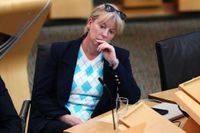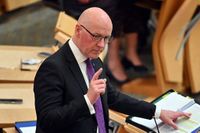Scotland’s public finances have come under renewed scrutiny following the release of the latest Government Expenditure and Revenue Scotland (GERS) report on August 13, 2025. The figures paint a complex picture of rising deficits, falling oil revenues, and persistent debates over the nation’s fiscal health and future direction.
The headline number is stark: Scotland’s net fiscal deficit for 2024-25 was estimated at £26.5 billion, or 11.7% of the country’s gross domestic product (GDP), according to the Scottish Government and as reported by BBC. This represents a significant deterioration from the previous year, when the deficit stood at £21.4 billion, or 9.7% of GDP. The fiscal gap has widened by £5.1 billion in just twelve months, a shift attributed largely to tumbling North Sea oil and gas revenues and rising public spending.
North Sea oil and gas tax receipts, once a vital contributor to Scotland’s coffers, fell by £0.8 billion in 2024-25—equivalent to 0.4% of GDP. The drop, which marks the second consecutive year of declining oil and gas revenue, was driven by lower energy prices and a dip in production. As a result, revenue from the North Sea shrank from £4.9 billion in 2023-24 to £4.1 billion this year. Excluding North Sea revenues, Scotland’s deficit balloons further, reaching £30.6 billion or 14.4% of GDP, as highlighted by The Herald.
On the revenue side, Scotland raised a total of £91.4 billion in 2024-25, accounting for 8% of all UK public sector revenue. Of this, non-North Sea revenues grew by £2.2 billion (2.5%) to £87.3 billion, driven primarily by increases in Scottish Income Tax and a nearly 20% rise in Land and Buildings Transaction Tax. However, this growth was partially offset by a reduction in National Insurance contributions, following a UK-wide cut announced in March 2024. Reserved revenues (excluding North Sea) fell by 0.8% of GDP, further squeezing the fiscal balance.
Yet, it was the surge in public spending that truly drove the deficit higher. Total public sector expenditure in Scotland soared to £117.6 billion, up £6.1 billion (5.5%) from the previous year, as reported by BBC and The Herald. This spending covered Scottish, UK, and local government outlays, including shared provisions such as defence and debt interest. Per person, public spending in Scotland reached £21,192—nearly £2,700 higher than the UK average of £18,523. This per capita gap widened by £358 compared to the previous year, underscoring the higher level of public services and benefits enjoyed north of the border.
Public spending in and for Scotland now accounts for 55.4% of GDP, far exceeding the UK-wide figure of 44.4%. Devolved expenditure alone rose by 1.2% of GDP, accounting for the lion’s share of the 1.9% deterioration in Scotland’s net fiscal balance. In raw numbers, devolved revenues reached £26 billion in 2024-25, a 9.7% increase from the previous year, but devolved expenditure stood at a much heftier £72 billion, having grown by 6.8% or £4.6 billion.
Finance Secretary Shona Robison sought to highlight the positives, noting, “For the fourth year in a row, devolved revenues have grown faster than devolved expenditure. Scotland’s public finances are better than many other parts of the UK, with the third highest revenue per person in the UK, behind only London and the South East.” She also emphasized that the GERS statistics “reflect only the current constitutional arrangements—of Scotland as part of the UK—and not an independent Scotland with its own policy, decisions on defence spending and the economy.”
Robison further argued that “the decisions we have taken here in Scotland are helping support sustainable public finances,” and pointed to Ireland’s recent economic performance as an example of what could be possible with independence: “If you look at Ireland and what they have been able to do with the powers they have, it’s like night and day compared to the economic conditions of the UK economy or the Scottish economy.”
However, not everyone is convinced by the government’s messaging. The Fraser of Allander Institute, a respected think tank, cautioned that the narrative around devolved revenues growing faster than devolved expenditure can be misleading. “The consequences of this could be to imply that the Scottish Government are running some kind of surplus on devolved budgets, but of course it does not work like that,” wrote João Sousa and Mairi Spowage in a widely cited analysis. “Devolved revenues are not the main source of funding for devolved spending, which remains the Block Grant, and the Scottish budget may not benefit from all the growth in devolved revenues, due to the operation of the fiscal framework.”
The Institute also noted that while devolved revenues rose by 9.7% to £26 billion, devolved expenditure, much higher at £72 billion, grew by 6.8%—meaning the absolute increase in spending far outstripped revenue growth. They further questioned the government’s presentation of defence spending, pointing out that while GERS allocates Scotland a population share of UK defence expenditure (£5.1 billion), only £2.1 billion was actually spent with industry in Scotland. This figure, however, omits personnel costs and overseas purchases, which, when included, show Scotland’s share of procurement is broadly in line with its population share.
Political reactions were swift and sharply divided. Scottish Secretary Ian Murray highlighted the benefits of UK-wide redistribution, stating, “By sharing resources with each other across the UK, Scots benefit by £2,669 more per head in public spending than the UK average. It also means that devolved governments have the financial heft of the wider UK behind them when taking decisions. That means more money for schools, hospitals and policing, if the Scottish Parliament chooses to invest in those areas.” He warned that “full fiscal autonomy would mean turbo-charged austerity and economic chaos for Scotland.”
Scottish Conservatives’ finance spokesman Craig Hoy echoed this sentiment, describing the “huge, and rising, Union dividend” and warning that independence would have “a catastrophic impact on the nation’s finances.” Meanwhile, business leaders voiced concern about the growing deficit. Michelle Ferguson, Director of CBI Scotland, called the figures “disappointing news for firms and households alike,” and urged both governments to “continue to back business through this difficult period.” She called for accelerated green freeport development, infrastructure investment, improved digital connectivity, and planning reforms to unlock growth.
In the end, the GERS report underscores the complexity of Scotland’s public finances. Revenues raised in Scotland cover many, but not all, of the public services and benefits provided, with significant gaps filled by UK-wide spending and redistribution. As debates over Scotland’s fiscal future and constitutional status continue, the numbers provide ammunition for both sides—fueling arguments for greater autonomy and independence on one hand, and for the security and scale of the Union on the other. The choices ahead will shape Scotland’s economic path for years to come.



